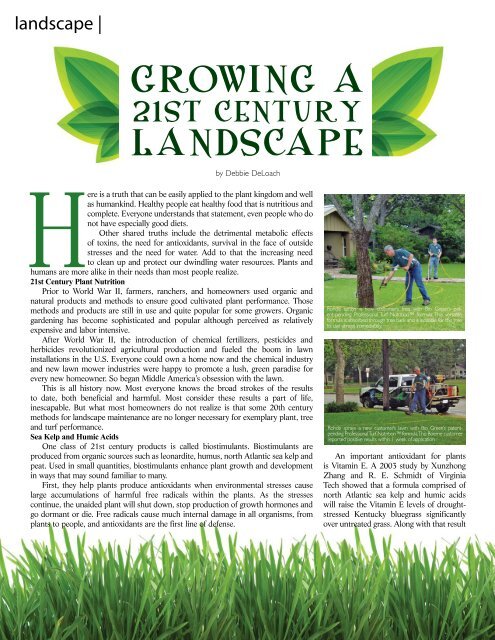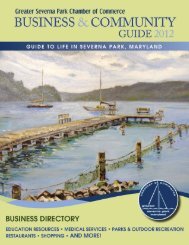Create successful ePaper yourself
Turn your PDF publications into a flip-book with our unique Google optimized e-Paper software.
landscape |by Debbie DeloachHere is a truth that can be easily applied to the plant kingdom and wellas humankind. Healthy people eat healthy food that is nutritious andcomplete. Everyone understands that statement, even people who donot have especially good diets.Other shared truths include the detrimental metabolic effectsof toxins, the need for antioxidants, survival in the face of outsidestresses and the need for water. Add to that the increasing needto clean up and protect our dwindling water resources. Plants andhumans are more alike in their needs than most people realize.21st Century Plant nutritionPrior to World War II, farmers, ranchers, and homeowners used organic andnatural products and methods to ensure good cultivated plant performance. Thosemethods and products are still in use and quite popular for some growers. Organicgardening has become sophisticated and popular although perceived as relativelyexpensive and labor intensive.After World War II, the introduction of chemical fertilizers, pesticides andherbicides revolutionized agricultural production and fueled the boom in lawninstallations in the U.S. Everyone could own a home now and the chemical industryand new lawn mower industries were happy to promote a lush, green paradise forevery new homeowner. So began Middle America’s obsession with the lawn.This is all history now. Most everyone knows the broad strokes of the resultsto date, both beneficial and harmful. Most consider these results a part of life,inescapable. But what most homeowners do not realize is that some 20th centurymethods for landscape maintenance are no longer necessary for exemplary plant, treeand turf performance.Sea kelp and humic AcidsOne class of 21st century products is called biostimulants. Biostimulants areproduced from organic sources such as leonardite, humus, north Atlantic sea kelp andpeat. Used in small quantities, biostimulants enhance plant growth and developmentin ways that may sound familiar to many.First, they help plants produce antioxidants when environmental stresses causelarge accumulations of harmful free radicals within the plants. As the stressescontinue, the unaided plant will shut down, stop production of growth hormones andgo dormant or die. Free radicals cause much internal damage in all organisms, fromplants to people, and antioxidants are the first line of defense.rohde sprays a new customer’s tree with Bio Green’s patent-pendingProfessional turf nutrition formula. this versatileformula is absorbed through tree bark and is available for the treeto use almost immediately.rohde sprays a new customer’s lawn with Bio Green’s patentpendingProfessional turf nutrition formula. this <strong>Boerne</strong> customerreported positive results within 1 week of application.An important antioxidant for plantsis Vitamin E. A 2003 study by XunzhongZhang and R. E. Schmidt of VirginiaTech showed that a formula comprised ofnorth Atlantic sea kelp and humic acidswill raise the Vitamin E levels of droughtstressedKentucky bluegrass significantlyover untreated grass. Along with that result24 <strong>Boerne</strong> Business Monthly n June 2012Debbie DeLoach is a sales representative for BioGreen of the Hill Country and has been in the hill country for less thana year. Prior to that she lived in Gainesville, Florida for 15 years where she owned a small business working as a gardenconsultant and freelance writer. She is a 12 year Master Gardener and a Certified Horticulture Professional through theFlorida Nursery, Growers and Landscape Association. For more information on the BioGreen service contact her at 830-431-3181 or debbied@biogreen.com.






